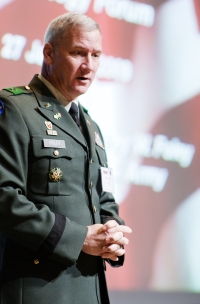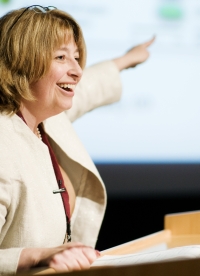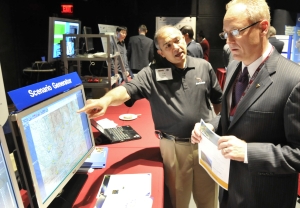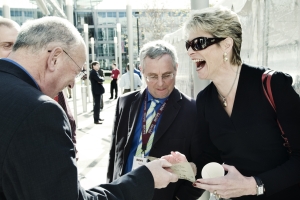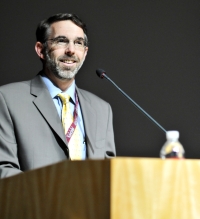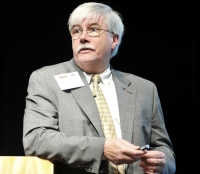First JTRS - SDR Forum Joint Meeting on Software-defined Radio a Hit
By Maureen C. Curran
|
San Diego, CA, February 19, 2009 — The first-ever combined meeting on software-defined radio (SDR) of the Joint Program Executive Office for the Joint Tactical Radio System (JPEO JTRS) and The SDR Forum attracted more than 240 registrants from across the globe to Atkinson Hall on January 26-29.
Representatives of the communications industry, defense technology communities, academia and government attended the four-day meeting which was the third in a series of JTRS Science and Technology forums (JSTeF 3) and the 61st general working meeting of The SDR Forum (SDRF).
By all accounts, the combination was quite successful.
"It has been a highly successful week," said John Chapin, chair of the SDRF, "We've had a great turnout, possibly a record for one of these January meetings. Just the energy of having all these people here talking about all these different things is great. During lunches and breaks, you could walk up to any group and they would be talking about something interesting."
"I think having both the JSTeF and SDR Forum together was a particularly fruitful combination," agreed Bill Hodgkiss, associate director of Calit2, "In part because it brought a larger cross-section of people in the SDR community together, although they might be working in different areas, commercial vs. government for example, they have many common interests."
|
There was a stellar lineup of keynote and invited speakers.
"I really appreciated having the chance to hear some fabulous outside speakers who were here because it's a JSTeF meeting," SDRF's Chapin declared. Chapin is a visiting scientist in the Research Laboratory of Electronics at the Massachusetts Institute of Technology and a consultant at Vanu, Inc.
In his opening keynote, Deputy Joint Program Executive Officer for JTRS, Howard Pace, thanked the keynote and invited speakers, calling them: "our honored guests, a fantastic gathering of people in the communications and signal worlds that is very important to our warfighter."
The keynote speakers, in addition to Pace, were Brigadier General Jeffrey W. Foley, (commander, U.S. Army Signal Center, commandant of the Signal School and Army Chief of Signal), Cynthia Dion-Schwarz (director, Information Systems, Deputy Under Secretary of Defense [Science and Technology] [DUSD (S&T)], Defense Research & Engineering [DDR&E]), and Katherine "KB" Bailey (director, International Programs for Program Executive Officer, Command, Control, Communications, Computers and Intelligence and Space (PEO C4I & Space) and JPEO JTRS).
|
The keynote and invited speakers were deemed outstanding by a large number of the attendees for presenting detailed overviews of many facets of the current state of software-defined radio, including funding opportunities and current and future technological needs of the U.S. Department of Defense (DoD) and its branches.
Phillip Duncan, vice-president of business development for MIMO radio specialist Silvus Technologies Inc. came down from Los Angeles to attend Thursday's sessions, which included a group of invited speakers from the Navy and Army research programs. "I came primarily because they were giving some overviews," he said, "It was very insightful information; they gave a good overview of where the military requirements are. There were very smart interesting people here at the meeting, it's a great place to learn about software-defined radio."
Thursday's invited speakers included Walter F. Jones (executive director, Office of Naval Research [ONR]), Gary Blohm (director, Space and Terrestrial Communications Directorate, CERDEC, U.S. Army), and Tony Fiuza (associate director for technology in the CERDEC Space and Terrestrial Communications Directorate [S&TCD]).
|
Calit2 was also invited to present the first round of results of their Calit2/JTRS SDR Project. Calit2 is engaged in a research effort supported by JPEO JTRS involving SCA SDR development platforms (porting the FM3TR waveform), a high performance amplifier (HPA) test-bed and hosting the JTRS Open Information Repository (where many of the presentations from JSTeF 3 will be available after the meeting).
Bill Hodgkiss, who is the principal investigator on the Calit2/JTRS SDR Project, opened the session with an overview of both the project and Calit2 itself. Per Johansson, the project manager of the Calit2/JTRS Project gave a technical presentation on the group's successful porting of FM3TR to an SCA SDR development platform (Spectrum Signal's SDR-4000). Arnold Cao presented another Calit2 SDR-related project, programmable radio test-beds and fast prototyping methodology (a Calit2/Ericsson project).
Attendees had many opportunities to learn about the state-of-the-art in software-defined radio research and applications, as well as network with attendees from all sizes of companies (including many primes), academic researchers, SBIR and STTR recipients, military program managers and researchers, and even some government and industry representatives from outside the U.S. In addition, an exhibition area provided an opportunity for SBIRs, STTRs and others to demonstrate their technologies and discuss their research with participants.
|
"I thought that this meeting was great! The exhibition room was by far the highlight of the trip," raved Tim Newman of Virginia Tech, "Getting a chance to see these prototypes and in some cases -- products, in action was a real treat." Newman is a postdoctoral researcher with Wireless @ Virginia Tech, the home of the Ossie SDR project.
"For our demo, we had to move our entire lab downstairs but once we were able to get everything set up and working, the fun began," recounted Anthony Nwokafor, a Calit2/JTRS Project researcher, "I would say about 80 to 100 people visited our booth over the three days and many of them were very interested in the work we had done."
Both groups of participants benefited from the overlap in meetings. Many of the JSTeF participants, both small business and academic, learned about the SDRF's commercial organizations and related activities, as well as the broader range of work that they are engaged in (for example, public safety). They also took part in many of the working group meetings.
"The SDR Forum group leaders have all commented that the extra participation from JSTeF attendees in their work groups, task groups and special interest groups during this meeting was really valuable," noted Lee Pucker, chief executive officer of the SDRF, "Through this participation, they were able to get several new insights into the various reports, specifications, and recommendations that they are developing."
|
In his closing address, Rich North, technical director for JPEO JTRS, wrapped up the highly successful meeting and expressed his desire to have another combined meeting, taking the best of this meeting and expanding on it.
"Everyone I talked to said joint meetings like this are something we should continue to do in the future," said SDRF's Pucker.
"I think that the mix of context and technology is very beneficial and healthy," said Calit2's Hodgkiss, also in agreement, "Then having the larger audience with the SDR Forum, and the commercial interest, was particularly valuable. So I'm looking forward to hopefully seeing us all get together again."
JPEO JTRS is a Department of Defense (DoD) acquisition command that is headquartered in San Diego. JPEO JTRS is responsible for the development and acquisition of tactical wireless communication systems for the Army, Air Force, Navy/Marine Corps, and other DoD-related users. JSTeF 3 is the third in a series of forums designed to build a community of academia, industry and government to advance the state of tactical radios and wireless networks. JTRS is developing an open architecture of cutting-edge radio waveform technology that allows multiple radio types (e.g., handheld, aircraft, maritime) to communicate with each other.
|
Established in 1996, The SDR Forum™ is a non-profit international industry association dedicated to promoting the success of next generation radio technologies. The Forum's 100-strong membership comprises world-class technical, business and government leaders from Europe, the Middle East, Africa, Asia and the Americas who are passionate about creating a revolution in wireless communications based on reconfigurable radio. Forum members span commercial, defense and civil government organizations at all levels of the wireless value chain and include service providers, operators, manufacturers, developers, regulatory agencies, and academia. SDR Forum is the only organization in the world dedicated to serving the industry's needs through advocacy, opportunity development, commercialization and education.
Related Links
Calit2/JTRS SDR Project
The Software Defined Radio Forum Inc. (SDR Forum)


